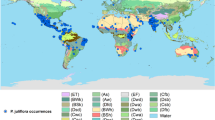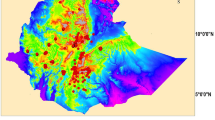Abstract
Accurate modeling of invasive species in areas of limited distribution of meteorological stations is challenging. In this regard, climate records from satellites are good alternatives. However, the accuracy of these datasets needs to be validated and their performance should be evaluated. Hence, this study aimed at evaluating the performance of four satellite-derived bioclimatic variables for modeling invasive Prosopis juliflora distribution in the dryland ecosystem of Ethiopia. Accordingly, WorldClim1.4 bioclimatic variables were used as a baseline to evaluate their performance, while, gauge-derived bioclimatic variables were used to validate all tested datasets. A total of 240 species occurrence and absence points were used to train and test the performance of all models using the Random Forest algorithm. Accordingly, satellite-derived bioclimatic variables provide better performance with an area under the curve of 0.64 and true skill statistics of 0.4 compared to a reanalysis and WorldClim1.4 derived bioclimatic variables. However, the lower performance of satellite datasets indicates the importance of its integration with other variables.





Similar content being viewed by others
References
Adhikari D, Tiwary R, Barik SK (2015) Modeling hotspots for invasive alien plants in India. PLoS ONE 10(7):e0134665
Ahmed N, Atzberger C, Zewdie W (2020) Integration of remote sensing and bioclimatic data for prediction of invasive species distribution in data-poor regions : a review on challenges and opportunities. Environ Syst Res 9(32):1–18
Ahmed N, Atzberger C, Zewdie W (2021) Species Distribution Modeling performance and its implication for Sentinel-2-based prediction of invasive Prosopis juliflora in lower Awash River basin Ethiopia. Ecol Proc 10(18):1–16
Akaffou SVE, Abrou NEJ, Tiébré MS (2020) Current and future distribution of. IOSR J Pharm Biol Sci 15(2):6–14
Amiri M, Tarkeshi M, Jafari R, Jetschke G (2020) Bioclimatic variables from precipitation and temperature records vs. remote sensing-based bioclimatic variables: which side can perform better in species distribution modeling? Ecol Inform 57(101060):1–16
Beaury EM, Fusco EJ, Jackson MR et al (2020) Incorporating climate change into invasive species management : insights from managers. Biol Invas 22(2):233–252
Datta A, Schweiger O, Kühn I (2020) Origin of climatic data can determine the transferability of species distribution models. NeoBiota 59:61–76
Deblauwe V, Droissart V, Bose R et al (2016) Remotely sensed temperature and precipitation data improve species distribution modeling in the tropics. Glob Ecol Biogeogr 25(4):443–454
Dinku T, Ceccato P, Kopec EG et al (2007) Validation of satellite rainfall products over East Africa’s complex topography. Int J Remote Sens 28(7):1503–1526
Engler R, Waser LT, Zimmermann NE et al (2013) Combining ensemble modeling and remote sensing for mapping individual tree species at high spatial resolution. For Ecol Manag 310:64–73
Fernandez M, Hamilton H, Kueppers L (2013) Characterizing uncertainty in species distribution models derived from interpolated weather station data. Ecosphere 4(5):1–17
Fick SE, Hijmans RJ (2017) WorldClim 2: new 1-km spatial resolution climate surfaces for global land areas. Int J Climatol 37:4302–4315
Gervais JA, Kovach R, Sepulveda A et al (2020) Climate-induced expansions of invasive species in the Paci fi c Northwest, North America: a synthesis of observations and projections. Biol Invas 22(7):2163–2183
Hijmans RJ, Cameron SE, Parra JL et al (2005) Very high resolution interpolated climate surfaces for global land areas. Int J Climatol 1978:1965–1978
Jensen T, Hass FS, Akbar MS et al (2020) Employing machine learning for detection of invasive species using sentinel-2 and aviris data: The case of Kudzu in the United States. Sustainability 12(9):1–16
Karger DN, Conrad O, Böhner J et al (2017) Data Descriptor : climatologies at high resolution for the earth’s land surface areas. Nat Publ Group 4(170122):1–20
Lembrechts JJ, Lenoir J, Haider S et al (2019) Comparing temperature data sources for use in species distribution models : from in-situ logging to remote sensing. Global Ecol Biogeogr 00:1–19
Liu Y, Shi J (2020) Predicting the potential global geographical distribution of two icerya species under climate change. Forests 11(684):1–19
Mbaabu P, Gichaba M, Olago D et al (2019) Spatial evolution of Prosopis invasion and its effects on LULC and livelihoods in Baringo Kenya. Remote Sens 11(10):1217
MoLF (2017) Federal democratic republic of ethiopia ministry of livestock and fisheries national strategy on prosopis juliflora management.
Naimi B, Araújo MB (2016) Sdm: A reproducible and extensible R platform for species distribution modeling. Ecography 39:001–008
Ng WT, de Oliveira C, Silva A, Rima P et al (2018) Ensemble approach for potential habitat mapping of invasive Prosopis spp in Turkana Kenya. Ecol Evolution 8(23):1–11
NMA (2021) National meteorological agency. http://www.ethiomet.gov.et/. (Accessed date 1 Feb 2021)
R Development Core Team (2020) R A language and environment for statistical computing. R foundation for statistical computing, Vienna, Australia. https://www.r-project.org/index.html
Shiferaw H, Schaffner U, Bewket W et al (2019a) Modeling the current fractional cover of an invasive alien plant and drivers of its invasion in a dryland ecosystem. Sci Rep 9(1576):1–12
Shiferaw H, Bewket W, Alamirew T et al (2019b) Implications of land use/land cover dynamics and Prosopis invasion on ecosystem service values in Afar Region, Ethiopia. Sci Total Environ 675:354–366
Shrestha UB, Shrestha BB (2019) Climate change amplifies plant invasion hotspots in Nepal. Divers Distrib 00:1–14
Sintayehu DW, Dalle G, Bobasa AF (2020a) Impacts of climate change on current and future invasion of Prosopis juliflora in Ethiopia: environmental and socio-economic implications. Heliyon 6(8):e04596
Sintayehu DW, Egeru A, Tim W, Elias N (2020b) Regional dynamics in distribution of Prosopis juliflora under predicted climate change in Africa. Trop Ecol 61:437–445
Tesfaye G, Tadesse T, Gessesse B, Dinku T (2017) Validation of new satellite rainfall products over the Upper Blue Nile. Atmos Meas Tech Discuss 11:1–24
Tilahun M, Birner R, Ilukor J (2017) Household-level preferences for mitigation of Prosopis juliflora invasion in the Afar region of Ethiopia: a contingent valuation. J Environ Planning Manage 60(2):282–308
Title PO, Bemmels JB (2017) ENVIREM: An expanded set of bioclimatic and topographic variables increases flexibility and improves performance of ecological niche modeling. BioRxiv 41(2):291–307
Vega GC, Pertierra LR, Olalla-tárraga MÁ (2017) Data Descriptor : MERRAclim, a high-resolution global dataset of remotely sensed bioclimatic variables for ecological modeling. Sci Data 4(170078):1–11
Wakie TT, Evangelista PH, Jarnevich CS, Laituri M (2014) Mapping current and potential distribution of non-native Prosopis Juliflora in the Afar region of Ethiopia. PLoS ONE 9(11):e112854
Yang XQ, Kushwaha SPS, Saran S, Xu J, Roy PS (2013) Maxent modeling for predicting the potential distribution of medicinal plant, Justicia adhatoda L. in Lesser Himalayan foothills. Ecol Eng 51:83–87
Acknowledgements
This paper is part of the doctoral study entitled “Role of remote sensing in invasive species distribution modeling, the case of the lower Awash River basin, Ethiopia”. We would like to thank Wollo University and the Ethiopian Space Science and Technology Institute (ESSTI) for allowing this doctoral study.
Author information
Authors and Affiliations
Corresponding author
Supplementary Information
Below is the link to the electronic supplementary material.
Rights and permissions
About this article
Cite this article
Ahmed, N., Atzberger, C. & Zewdie, W. Remote sensing-derived bioclimatic variables for modeling invasive Prosopis juliflora distribution in a region of limited meteorological stations. Trop Ecol 63, 94–103 (2022). https://doi.org/10.1007/s42965-021-00193-y
Received:
Revised:
Accepted:
Published:
Issue Date:
DOI: https://doi.org/10.1007/s42965-021-00193-y




